Fight Over Custer Statue in Monroe, Michigan, Comes to a Standstill
The bronze sculpture has cast a shadow over the township as residents have been debating over the future of the monument for more than a year.
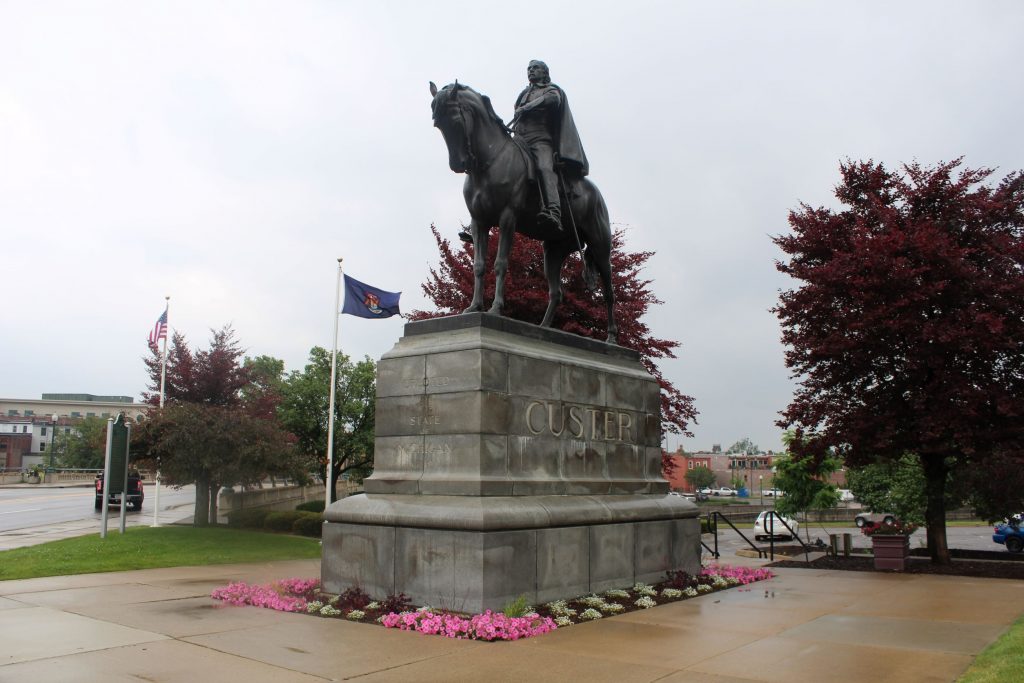
Before he became a legend after his death in 1876 at the Battle of Little Bighorn in present-day Montana, George Armstrong Custer was known as a skilled cavalryman, fighting for the Union Army in the Civil War.
His military successes are celebrated in the form of a statue located just north of downtown Monroe, Michigan. The bronze sculpture depicts Custer riding on a horse and towers over anyone beneath it. For more than a year it’s cast a shadow over the township as the community has been fighting about what to do with it. Perhaps the Battle of Little Bighorn wasn’t Custer’s last stand after all.
Listen: Find out what happened when activists protested a Custer statue in Monroe.
Activists Compare Custer to Hitler
In a park just across a parking lot from the monument, about 25 people have gathered on the 145th anniversary of the Battle of Little Bighorn. A small group of men drum and sing on stage, while one man dances in traditional Native American dress. Despite the anniversary date, the crowd is not here to honor Custer — they’re here to protest his statue.
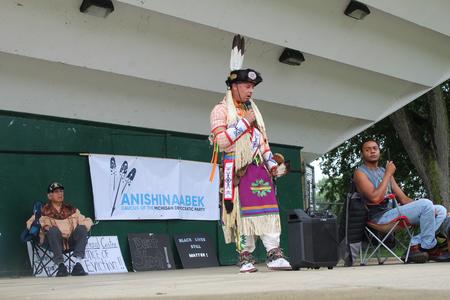
“We would like to have the statue relocated or removed indefinitely,” says Katybeth Davis, a Monroe Charter Township resident. In the spring of 2020 she started a petition to remove the Custer monument. Since then more than 14,000 people have signed on. Davis says she decided to start the petition while participating in Black Lives Matter demonstrations after the murder of George Floyd.
“And while we were protesting, people were driving by telling us to remember where we came from and calling us racial slurs, savages — basically, threatening our lives,” says Davis. “So it dawned on me that this racism is so systemic and it’s institutional.”
Davis and other activists compare Custer to Hitler, saying he wanted to wipe out American Indians. One commonly cited example is the Massacre of Washita. After being hired by the U.S. government to fight the Plains Indians, Custer and his men initiated an unprovoked attack against a group of Cheyenne living on reservation land. Custer claimed his soldiers took the lives of 103 Indians. Cheyenne & Arapaho Nation Indians said only 60 Indians were killed. The village population was estimated to be 250-300 people.
“Most Indian fights didn’t have casualty levels that high. He inflicted a pretty heavy blow on that Cheyenne village,” says Gregory J. W. Urwin, a Temple University History professor.
“General Custer is not fit to walk amongst the men and women of this country’s military. There was no integrity or courage or anything redeemable in his military performance,” Southeast Michigan resident Chris Franklin tells the audience at the protest. Franklin stands on stage wearing a baseball cap that says “Native American Veteran.”
“It is not heroic to ride into a defenseless village and murder and mutilate women, children and elderly. These are the actions of a coward,” says Franklin.
Residents See Custer as a Hero
Many people in Monroe, however, refuse to see Custer as anything but a hero. For these residents, Custer is a huge source of local pride. Although he was born in Ohio, he went to school in Monroe and met his wife there.
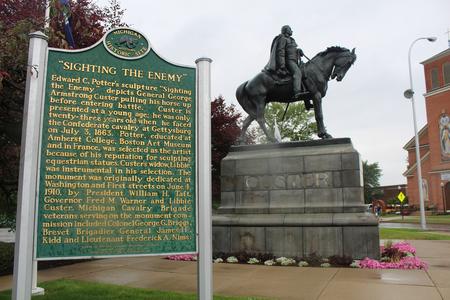
“He thought of Monroe as his second home,” says Urwin.
In the city, many things are named after the general — Custer Airport, Custer Road, Custer Elementary School. And relics of his past, like a family barn, are preserved and highlighted for tourists.
Resident Nancy Barron says her family has lived in Monroe for more than 200 years.
“Are you going to tear down the signs, tear down the statue, blow up the farm, dig up the Custers in the cemetery? Where does this end?” Barron asked during the public comment portion of a City Council meeting. “Custer is a part of this community and will always be, regardless of how you feel about him.”
Bring in the Moderator
Comments from both sides of the statue debate were regularly expressed at City Council meetings over the course of the past year. Eventually, Monroe officials decided they would hire an independent facilitator to lead a series of community meetings to determine what to do with the monument. Monroe City Manager Vince Pastue says he put a Request for Qualifications together with the mayor, the city manager, a member of the Michigan Historical Commission and the director of the Monroe County Museum. He says looking at the makeup of the group, it was clear why they needed to bring in a third party to facilitate discussions.
“This is just literally a microcosm of our problems right now that we face in this country. We cannot have an honest conversation with one another over items that we disagree with.” –Vince Pastue, Monroe city manager
“At the end of the day, and we kind of laugh about it, ‘Do you need five white guys making this determination for you?’” says Pastue. “We think it’s obviously important that if it’s going to be a successful community engagement that it has to be viewed by all parties as being objective and impartial.”
Pastue felt at the time that the engagement project could serve as a model for communities across the country facing similar dilemmas with their monuments. After receiving four proposals, his team selected a firm to recommend to council. They chose one that they said has a track record of community outreach in Michigan — a Black woman-led company known as E. Austell Associates. But weeks before the consultant’s proposal was scheduled to be voted on by council, public outcry ensued.
A Microcosm for the Country?
The pro-Custer side was upset that the city was planning to spend up to $50,000 on the community engagement project. At the same time, the anti-Custer side was upset that one of the candidates, a Native American historian, had not been interviewed. Critics called the whole process a hoax.
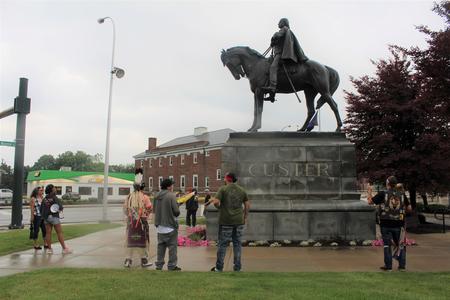
Under fire from both directions, the council retreated. It voted to abandon the facilitation project and any funds associated with it.
“My position is I don’t want to put the city council or the city into a position where we’re spending taxpayers’ dollars no one is going to accept the results because there’s going to be one side that doesn’t get everything they want,” Council Member John Iacoangeli said during a meeting.
Pastue says he’s disappointed, but not completely surprised by the outcome.
“This is just literally a microcosm of our problems right now that we face in this country. We cannot have an honest conversation with one another over items that we disagree with,” says Pastue.
Whether the issue is masks, vaccines or Black Lives Matter, Pastue says, “it’s just one side or the other and nobody’s going to yield. You pick your your position and you don’t waver from it.”
The Future of the Statue
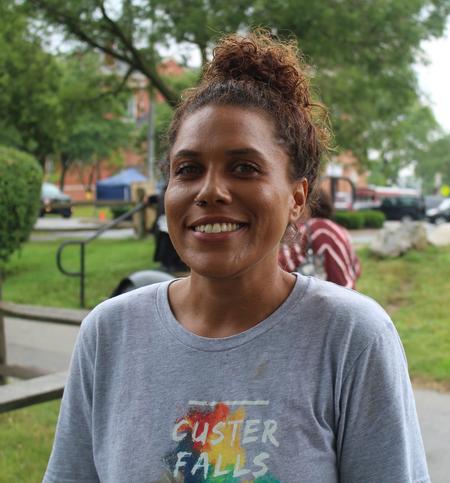
As for the fate of the statue, Katybeth Davis, the resident who started the petition, isn’t backing down. During the public comment portion of the meeting where the facilitation project was killed, Davis says she’s prepared to circulate more petitions and pressure council to change the name of everything in the area associated with Custer.
“And I am letting you guys know right now, I’m only 37 years old. I have nothing but time, resources and energy. I will come here to every single meeting, just like I have for the last year and a half. And I will stand up here and take my 3 minutes just like I have every single meeting,” says Davis.
With the help of other activists, she also introduced a resolution to several county Democratic parties urging that the sculpture be removed from the state and donated to the federal government.
The City of Monroe, however, says there are currently no plans to alter the monument. As far as the city is concerned, Custer’s statue will continue to stand for the foreseeable future.
Correction appended 2:21 p.m.September 10, 2021: The original version of this story has been updated to provide additional context regarding the number of Cheyenne casualties in Washita reported by both Custer and the Cheyenne & Arapaho Nation Indians.
Trusted, accurate, up-to-date.
WDET strives to make our journalism accessible to everyone. As a public media institution, we maintain our journalistic integrity through independent support from readers like you. If you value WDET as your source of news, music and conversation, please make a gift today.
